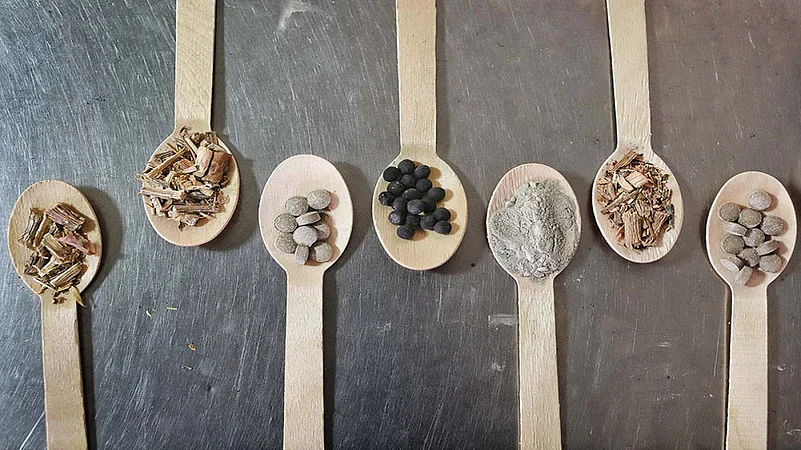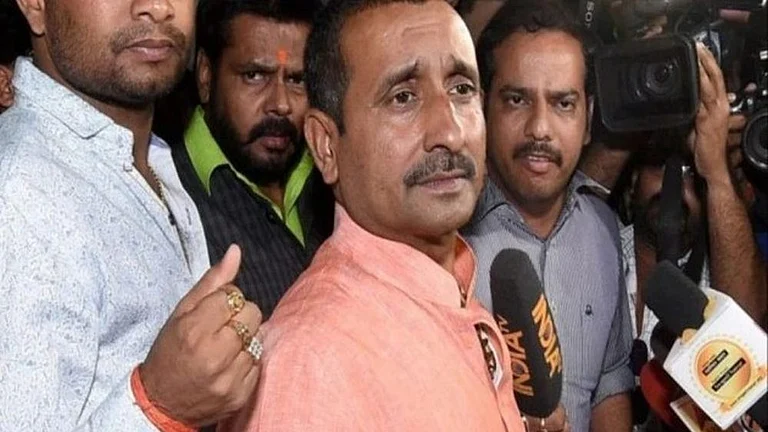For a modern medical world often characterised by an undue amount of self-confidence—and not a little dogmatism—COVID-19 came as a tipping point. It destabilised fixed opinions and brought a new spirit of doubt, questioning and self-critique. Among the effects this has had was to renew interest in alternative therapeutic systems. In India, the Ayurveda medical system, hitherto relegated to the sidelines, was suddenly back in focus in a new way. As was an old debate—rather, a conversation—the terms of which had never really been worked out to satisfaction, let alone its details.
Even if the shock of the pandemic on human society was immediate, the process of rethink it set in motion was slow, and unfolded over months of double-blind darkness, so to speak. As modern medical science continued to struggle to demystify the various manifestations of the Severe Acute Respiratory Syndrome Corona Virus 2 (SARS-CoV-2), people the world over took to alternative and complementary medicine in panic and desperation. There was also method. Chinese Traditional Medicine was incorporated as part of treatment modalities and they have reportedly shown good results. Science strode along bravely, meanwhile. Hundreds of studies emerged in over a year from various quarters of the world, beginning with the Chinese scientific community—every case study offering new insights, becoming important in understanding at least one aspect of how the virus affects the human body. A process that is still going on, with all studies at various points of re-evaluation.
ALSO READ: Ayurveda The Alter Native?
It was amidst this scenario of confusion and some hard-won aspects of clarity that Ayurveda gained some reckoning, mainly as preventive therapy initially, and eventually to become part of the treatment modality. Even if, perhaps, it is yet to get its due recognition or be accepted by the ‘vocal’ majority—including those who could control the scientific consensus. One powerful actor, however, tried to change the script with the force of dramatic decree: the Union government. With its loyalties firmly on the ‘Indic’ side, it stirred up the waters, and sought to impart an impetus to activities around the indigenous system. As a result, energy was gained, but perhaps not necessarily in the form of light. Much more than the Ayurveda community, the pharmaceutical and the food supplement businesses seem to have taken the Centre’s cue rather overtly. The result had been an overuse of the ‘immunity’ tag in products that soon flooded the FMCG market.
Meanwhile, the challenges in integrating the traditional treatment system into modern protocols remain vast and profound, and Ayurveda has a sense of self-awareness about it. COVID-19 is as good a test case as any. Even as people have been prone to going gung-ho over Ayurveda’s potential here, “the system has itself never claimed any cure for COVID-19”, says Dr P. Rammanohar, director, Amrita Centre for Advanced Research in Ayurveda, located in the Amritapuri campus in Kerala’s Kollam district, an institute devoted to working on both the conceptual foundations and the empirical, clinical side. “Cure means stopping viral replication. Unless rigorous studies are done, one cannot claim cure,” he adds.
What, then, is happening? Well, as of now, what Ayurveda has been drafted into majorly is supportive care for Covid—the protocols for this were decided by the Union ministry of Ayush (Ayurveda, yoga, unani, siddha, homoeopathy) on the recommendations of a team of top-level scientists, with references of epidemics cited from ancient texts. Now, most ancient Ayurvedic texts mention epidemics. “The Sushruta Samhita describes instances of such diseases affecting the respiratory system that even cause a loss of smell,” says Dr Rammanohar, who is also a member of the COVID-19 Task Force under the Union ministry of Ayush.

What is the gap that remains? The dominant medical system, based on evidence, calls for data and this is where Ayurveda had been found faltering in most treatment modalities. “But not anymore,” says Dr V. Rajmohan, coordinator of the State Ayurveda COVID-19 Response Cell (SACRC) in Kerala. The kind of documentation being done for COVID-19 is unprecedented in Ayurveda, says Dr Rajmohan. Data has been collected from district level and collated for the state in a systematic manner. Kerala, one of India’s strongest redoubts of Ayurvedic culture, is well placed to undertake this.
Project Amrutham, which gave preventive medical care to people in quarantine in government-run establishments, and Project Punarjani, meant for post-infection rehabilitation of Covid patients, were evolved by Kerala even when Ayurveda had not been formally brought in by the Centre in the COVID-19 context. Both have provided a wealth of data for the Ayurvedic research community, but the state government has been on the backfoot in publishing them so far. K.K. Shailaja, Kerala’s health minister, told this writer, “Ayurveda has produced some very good results. It was lack of time and not lack of intent that held us back in publishing the reports.”
ALSO READ: Let’s Stop Promoting Mixopathy
Ayurveda physicians were not hands-on with COVID-19 patients initially anywhere in India, but with large numbers of patients overwhelming modern medical facilities unprepared for the deluge, they eventually spilled over to Ayurveda facilities. That’s when the encounter happened in earnest and Ayurveda faced one of the modern world’s biggest medical mysteries. The feedback was very good and gave confidence to Ayurvedic practitioners, says Rammanohar. Earlier, only mild cases were reaching Ayurveda facilities, but later even moderate to severe cases started accessing Ayurveda, he says. This galvanised the Ayurvedic community: a flurry of activity ensued, and practitioners published a number of original case—studies. The clinical experimentation was comparable to what happened within modern medicine in India, which was busy firefighting, he says. Most of the peer-reviewed works or case studies in modern medicine came up in other countries, led by the US, the UK, Italy and China.
In a fascinating subplot to the Covid story, Ayurvedic researchers threw themselves to the task of grappling with this new disease. This is despite the fact that they could not access the virus initially, limiting the way Ayurveda could conduct its investigations. Ayurvedic physicians had to rely on information from the modern system. “Ayurvedic researchers could not even do in-vitro research as the virus was not made available to the community,” adds Rammanohar.
The story is fascinating because here we see the outlines of a conversation between two systems fundamentally mismatched in their theory and epistemological basis. The conceptual confusion brought about by that mismatch means Ayurveda denotes different things to different people. It is tradition, according to one group, hence not backed by scientific enquiry. Another group insists, more driven by instinct than knowledge, that Ayurveda is purely scientific. For most of the general public, anything traditional does not anyway require a scientific backing. Even an element of faith comes in. The result: despite being one of the world’s oldest systems of medical treatment, which continues to the present times without changing its fundamental principles as written down in texts dating over millennia, it is also the most ‘under’-understood system when seen juxtaposed with the modern system. People have more exposure to modern medical concepts now, but not Ayurveda. Unless these concepts are taught at the school level, people will not be able to grasp their essentials. Most of India’s elderly population had a level of familiarity with the concepts, or at least its practical side—the terminology, the use of certain herbs and so on. But as modern education system brought in new concepts—especially from modern science—what we now call “traditional knowledge” has taken on the aspect of something rudimentary and inductive, if not unsystematic. It exists, but does not make much sense to people.

As the noted cardiothoracic surgeon Dr M.S. Valiathan says in his book Ayurvedic Inheritance: A Reader’s Companion, there were no ready validations for older practices because the scientific meanings would have been lost over the centuries, or the practices may have been popularised as a ritual rather than as a scientific habit to prevent diseases. Though translations of Ayurvedic texts had been done earlier, which included into the Tibetan and Persian languages too, it was Valiathan’s work over the last 20 years that gave Ayurveda some reckoning among the scientific community. Here was a savant from modern medicine seeking to understand Ayurveda according to its own terms, instead of merely being a reflexive critic.
Even fifty years ago, Ayurvedic practices were known to households, being quite enmeshed with traditional lifestyles. Eating light when ill and going on a liquid diet to assist easy digestion, fasting during stomach upsets, having foods of medicinal value during certain seasons—these had evolved, and stayed, as tradition till modernity ruptured that continuity. One essential aspect about the traditional approach was also lost. That Ayurveda is not just a treatment system, it is a whole way of life—it works towards bolstering the body metabolism and mechanism to optimal levels against the vagaries of nature, says Dr Pavana J, an Ayurvedic practitioner in Kerala.
Social habits were one thing. There also remained, within the community of healers, the task of continuing traditional Ayurvedic education itself into the modern age. For the system to migrate to the new world, its essential spirit unchanged. Independence brought an initial boost, but it was only in the 1970s that the current format of Ayurveda learning and teaching was adopted. With the system peopled, for an interregnum, by those with no formal training in medicine—either institutional, or from a gurukul, as of old—Ayurvedic practice had fallen into an abyss. Even as modern medicine progressed, with technological leaps at every level, the older system struggled. It was from here that the government sought to provide a more scientific orientation.
Embracing modernity
Ayurveda finally found its footing in modernity with the development of products. Indeed, over the last two decades, in the new millennium, Ayurveda has been prolific in introducing newer products into the system. Many traditional practitioners, though, wonder if this is the right direction. In actual practice, about 15-20 formulations are enough to handle a wide range of diseases, say many practitioners. Ayurvedic texts have thousands of formulations and there’s little need for any new product, says Dr Remya Krishnan, professor of Ayurvedic pharmacology in the Rajiv Gandhi Institute of Ayurveda, Mahe. Research work should involve probing more into the texts, she says. Now, these texts can in themselves sustain the definition of being ‘scientific’ and ‘evidence-based’—even WHO considers literature as ‘evidence’ if the cited medicines are still in use—but what we can surely aim for is a process of trial and explication in modern terms, besides even trying for extensions and new applications in a methodical manner. Harilal Madhavan, faculty member, Indian Institute of Scientific Education and Research, too says while Ayurveda may have recovered with the growth of its pharmaceutical products, this may really not be indicative of advances in the system itself.
But Rammanohar says new drug formulation is part of Ayurveda, except that priority should be on quality, safety and efficacy. “If we ensure there’s no heavy metal or pesticide contamination, that can help earn Ayurveda more support all around. Efficacy will follow, that can be gauged by proper documentation and analysis of clinical outcomes.” Investment is required for all this, he says. “Actually, a registry of clinical practices will bring together a lot of functional knowledge on a domain, from where at least some ten major areas can be picked where Ayurvedic treatment has provided cure or had better health outcomes. These can become focus areas.”
Ayurveda already has some well-known strengths—musculo-skeletal disorders, osteoarthritis, lumbar-arthritis, skin disorders like psoriasis among them. What’s needed is ‘translational re-search’ and an emphasis on clinical wisdom, says Dr Sheela Karalam, industrial pharmaceutical researcher, who has to her credit the record of developing and modifying 28 drugs while at Oushadhi, affiliated to the Pharmaceutical Corporation Kerala Ltd. Currently at Vaidyamadom Ayurvedic Research Centre in Thrissur, Kerala, she says this entails taking cues from traditional and clinical practice and developing them in laboratories, guided by scientific principles. This can offer benefits across many traditional practices that exist without any scientific validation, she says. Madhavan, who has specialised in economic and interdisciplinary research in Asian indigenous medicines, too advocates taking a cue from knowledge embedded in tradition and developing it in evidence-based ways. He cites Jeevani, an Ayurvedic product developed out of tribal practice through scientific research, as an example. Rammanohar points to an additional area of urgency within Ayurvedic biomedicine: the need to explore the use of more herbs so as to reduce the stress on the limited numbers of herbs used in formulations. The catalogue of Indian medicinal sources lists about 10,000 herbs, but only 300 are used, and these plants are inevitably over-exploited. Alternative herbs would be a sustainable way to go. But the primary work, he says, is to evolve a conceptual framework—with a rational, universally translatable language—within which to ground the methodology of testing Ayurvedic drug formulations. The present system of testing is based on modern medicine which, says Rammanohar, is inadequate in understanding Ayurvedic formulations.
All medical sciences need to be updated, be it Ayurveda or modern medicine, feels Dr S. Gopakumar, associate professor and head, Roganidana (Aetiology), Government Ayurveda Medical College (GAMC), Thiruvananthapuram, Kerala. “Among the many fevers described in Ayurvedic texts, in one context it is mentioned how fever spreads—by touch, via the nose, or if hugged or by wearing clothes worn by others. While we now wear masks and avoid shaking hands, we are also updating knowledge from over 3,000 years ago. We now know a virus is causing the disease and that it spreads through droplet infection. We are empowering our Ayurvedic knowledge by including new information,” says Gopakumar.
Doubtless, a modern testing protocol is important to evaluate how a regime is working, and Ayurveda does offer such flexibility, says Dr K. Murali, chief editor of the publication division of Kottakkal Arya Vaidya Sala and former superintendent of GAMC Hospital, Tripunithura, Kerala. COVID-19, by throwing up some new unknowns for all human knowledge, has provided a platform for Ayurveda to evaluate its strength. The jury is still out on where Ayurveda stands in the evolution of our healthcare system, one that surely needs to have a modern form of validation. There is reluctance, and even incredulity. Some from the scientific community welcome Ayurvedic research findings, others dither, yet another group is still scathing. But new thinking has always found opposition, and hasn’t science always prospered from dialogue and debate?
(Shyama Rajagopal is an independent journalist based in Kochi, and is presently researching aspects of Ayurveda practice under a grant. Views expressed are personal.)





















